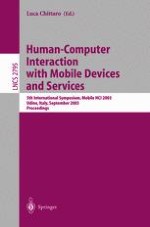2003 | Buch
Human-Computer Interaction with Mobile Devices and Services
5th International Symposium, Mobile HCI 2003, Udine, Italy, September 2003. Proceedings
herausgegeben von: Luca Chittaro
Verlag: Springer Berlin Heidelberg
Buchreihe : Lecture Notes in Computer Science
Enthalten in: Professional Book Archive
